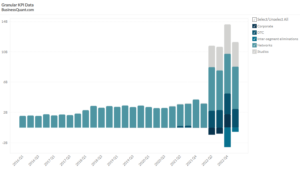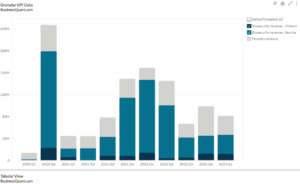
Lyft Inc’s Revenue per Active Rider (2016-2023)
Exclusive Data
You need the Pro Plan to access KPI data
- Full access to the platform
- KPI data & segment financials on US stocks
- Financial data on thousands of stocks
- Download data in xlsx and csv formats
Pro Plan
$49 per month*
60% discount ends in:
.
About
More information
Subscribe to Pro or Enterprise plans to unlock this feature.
Contact the Analyst
Subscribe to Pro or Enterprise plans to unlock this feature.
Become a smarter investor today.
Access KPIs & Segment Financials on US stocks
This statistic highlights Lyft Inc’s Revenue per Active Rider, reported on a quarterly basis from 2016 onwards.
Lyft, Inc. offers online carpooling services. The company provides boarding reservations, payment processing, and car transportation services. Lyft serves customers in the United States. Founded in 2012 by Logan Green and John Zimmer, it aims to improve people’s lives on the world’s best transportation. Lyft is available in about 95% of the United States and some cities of Canada.
What is Revenue per Active Rider?
Lyft defines an active driver as any driver who travels at least once on a multi-modal platform via the Lyft app during the quarter. If a ride is requested by an organization that uses the concierge service on behalf of the rider, it will be excluded from the active rider calculation as it does not require the use of the Lyft app. For acquired companies, only riders who ride through the Lyft app during the quarter or rent a bike or scooter are counted as active riders. In addition, Active Rider’s calculations are not based on standardized industry methodologies and are not necessarily calculated in the same or equivalent manner as indicators of similar titles from other companies. Lyft generally defines revenue per active driver as quarterly revenue divided by the number of active drivers in the same quarter.
Lyft Inc’s Revenue per Active Rider
| Category | Q2 2020 | Q3 2020 | Q4 2020 | Q1 2021 | Q2 2021 | Q3 2021 |
| Revenue per Active Rider | $39.1 | $39.9 | $44.4 | $45.1 | $44.6 | $45.6 |
Lyft Inc’s Revenue per Active Rider grew from $39.9 in Q3 2020 to $45.6 in Q3 2021, marking a 14.28% increase on a year-on-year basis. It increased from $44.6 million in Q2 2021 to $45.6 million in Q3 2021, marking a 2.24% growth on quarter-on-quarter basis. Also, the revenue grew from $39.9 in Q3 2020 to $44.6 in Q2 2021, indicating a growth of 11.77%.
In 2020, the revenue per active rider grew slightly from $39.1 in Q2 2020 to $39.9 in Q3 2020, marking an incline of 2.04%. This incline continued as revenue rose to $44.4 in Q4 2020, accounting for an increase of 11.27 %.
In 2021, there was again an increase of about 1.57%, as revenue per active rider rose to $45.1 in Q1 2021. However, this was followed by a decline of 1.10% as revenue per active rider decreased to $44.6 in Q2 2021. This loss was recovered as again revenue per active rider rose to $45.6 in Q3 2021, registering a growth of 2.42%.
On an overall analysis of the past five years, it can be seen that revenue per active rider has witnessed an upward trend, from $18 in Q3 2016 to $45.6 in Q3 2021, marking a sharp growth of 153.33%. It is also witnessed that revenue per active rider is on the constant rise from Q3 2016 to Q1 2020. This was followed by a minor dip of 1.10% as revenue declined from $45.1 in Q1 2021 to $44.6 in Q2 2021.
About the Company
Lyft is the second-largest ridesharing company in the United States, after Uber, with a 32 per cent market share. It focuses solely on enhancing people’s lives by providing the world’s best transportation and are devoted to developing safe, economical, and sustainable transportation. Lyft is an on-demand taxi booking platform that is regarded as one of the fastest-growing firms in the United States. Lyft was started in 2012 and now has a user base of over 30 million riders and 2 million drivers. A firm based in the United States that develops, markets, and manages a mobile app that provides ride-hailing, vehicle rental, motorized scooters, a bicycle-sharing system, rental automobiles, and food delivery. It is headquartered in San Francisco, California, and operates in 644 US cities and 12 Canadian communities.
Lyft does not own any vehicles; instead, each booking earns a commission. The fare price is communicated to the consumer prior to the ride. These prices keep on changing from time to time, depending upon the local demand and supply. It is giving ride-hailing competitors a run for their money. In 2014, they also debuted the shared-ride concept. During the same year, they recruited two businesses to deal with regulatory issues. In 2018, they debuted a fleet of electric scooters. The common stock of the company is publicly traded on NASDAQ under the symbol “LYFT” and is a component of the Russell 1000.
Did you like Lyft Inc’s Revenue per Active Rider statistic?
Access more such Key Performance Indicator (KPI) data points and segment financials, on thousands of US stocks, with Business Quant.
You can get started here.
More data on US Stocks

Our Plans
Always know what you’ll pay. No hidden costs or surprises.
- Annual
- Monthly
60% discount till April 30
Pro
For serious investing
-
Company KPI data Access segment financials, non-GAAP metrics and KPI data from presentations and filings. Examples include financials by segment / region / product category, AT&T's broadband subscriber trends, Tesla's deliveries by model and lots more.
-
Stock research tools Features include : stock screener, stock comparison, industry financials, stock warnings, advanced charting tools, timeseries tables, scatter charts, financial statements, stock reports, SEC filings, stock ratings, institutional and insider ownership data. There are 200+ financial items and ratios on thousands of US stocks.
-
Industry data & tools Access premium operating data on 40+ industries. Examples include market share, smartphone shipments by vendor, subscribers by wireless carrier, historical gold production. There are 20,000+ such statistics.
Enterprise
For tailored workflows
-
All of Pro plan Get unfettered access to all our dashboards and dossiers.
-
Custom built features Get tailored dashboards built specially for you , based on your set of requirements, to simplify your research workflow.
-
Admin billing Back-end documentation support and multi-seat licensing.
* Billed annually, local taxes extra.
60% discount on Annual plan
Pro
For serious investing
-
Company KPI data Access segment financials, non-GAAP metrics and KPI data from presentations and filings. Examples include financials by segment / region / product category, AT&T's broadband subscriber trends, Tesla's deliveries by model and lots more.
-
Stock research tools Features include : stock screener, stock comparison, industry financials, stock warnings, advanced charting tools, timeseries tables, scatter charts, financial statements, stock reports, SEC filings, stock ratings, institutional and insider ownership data. There are 200+ financial items and ratios on thousands of US stocks.
-
Industry data & tools Access premium operating data on 40+ industries. Examples include market share, smartphone shipments by vendor, subscribers by wireless carrier, historical gold production. There are 20,000+ such statistics.
Enterprise
For tailored workflows
-
All of Pro plan Get unfettered access to all our features.
-
Custom built features Get tailored dashboards built specially for you , based on your set of requirements, to simplify your research workflow.
-
Admin billing Back-end documentation support and multi-seat licensing.
* Local taxes extra.






